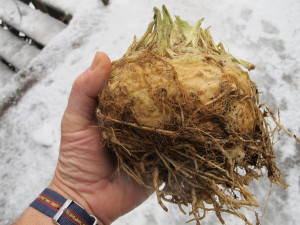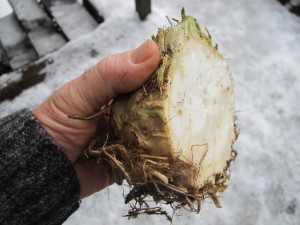Eating from the Garden
Here it is, officially winter, and I’m still eating from my garden. I recently made what I call a winter salad: grated carrot and celery root (also known as celeriac) with a vinaigrette sauce. Sometimes my winter salad also gets grated or chopped apple, or some dried cherry tomatoes. Only the ingredients for dressing are bought – vinegar and oil – though I have been known to even make my own vinegar some years. Of course dried currants or raisins are also nice in that salad, but I don’t grow those. I could put in dried blueberries, as I do dry a few each year, but haven’t tried them in the salad yet.
Celeriac is an unsung hero. Most gardeners don’t grow it. Most gardeners should. It’s a root crop related to celery, has a similar flavor, and the leaves are nearly identical. Unlike most root crops, the bulk of this root sits up above the ground level. The meat of this vegetable has the consistency of a carrot, but it is white and round. Mine grow to be 3 to 6 inches in diameter.
Celeriac stores well and stays tasty for months. In the fall I cut off the tops, cut back most of the roots, and wash out the dirt from the thick mass of roots. Then it will store for 3 to 4 months in a cool place with high humidity. You could do this by putting the celeriac in a plastic bin or bucket and storing it a cool place that stays in the 33 to 50 degree range. To keep the humidity high you can put an inch of moist sand in the bottom of the bucket.
Another way to store celeriac, carrots, potatoes, kohlrabi and rutabagas is to get an old fridge. Often older model fridges are available free from on-line list serves – or even in your daily newspaper. That’s how I got a 1946 GE model that still works fine, and it does not have the undesirable “frost free” feature. Modern refrigerators remove the humidity from all but the vegetable drawers. But many older ones do not, and thus are great for filling up with storage vegetables. Or, one can store veggies in modern fridges in plastic bags that have been punched with many holes using a paper punch.
Unfortunately, many garden centers do not sell celeriac seedlings in the spring. So if you want to grow celeriac, you may want to order seeds this winter when you put together you seed order. I start them indoors, starting in early- to mid- March. They are a bit slow to germinate, and need consistent moisture from planting to harvest. They don’t like cold weather or soil in the spring, so I transplant them into the ground in June.
Celeriac needs soil that doesn’t dry out. Sandy soils do not hold moisture well, while heavier, clay-based soils do. If you have a light, sandy soil, do not grow celeriac in raised beds, as raised beds tend to drain off and dry out more quickly. And add lots of compost to the soil before planting, as compost tends to act a bit like a sponge, holding water.
In addition to using celeriac in my winter salad, I use celeriac in stir fries, soups and stews. It adds a celery flavor – and a richness – that I like. And I haven’t had much luck growing celery. When I’ve tried in the past, I had trouble with slugs, the stems have been spindly, and celery in general does not store as well as celeriac.
My friend Ed Smith of Cabot, Vermont, is the author of a number of excellent gardening books, including The Vegetable Gardener’s Container Bible. I called him recently to see how he grows celery, as I recalled that he does well with it. He told me that new no longer grows celery in the ground. He only grows it in self-watering containers.
Ed told me that he gets containers from Gardeners Supply (www.gardeners.com) that are roughly 3-feet square and 12 inches deep. At the bottom of each container is a reservoir that holds a couple of inches of water separated from the soil mix by a plastic barrier; it has a wicking system that keeps the soil consistently moist, but not soggy. In his big container he plants 18 to 20 plants, and puts it in full sun.
For a soil mix Ed uses a 50-50 mix of compost and peat moss, and he adds a cup of organic fertilizer and usually some Azomite. Azomite is a rock powder sold in 50-lb bags that has trace minerals not found in fertilizers.
The key to success with celery, according to Ed, is to keep it consistently moist and pick it small. Don’t wait until your celery looks like the stuff from the grocery store, pick it when the stalks are small, say half an inch in diameter. He doesn’t usually start his own plants as they take a long time to grow, but buys plants from a greenhouse. Ed told me that he chops up his celery and freezes it in pint zipper bags. Then he uses is all year in soups and stews. He does not blanch it before freezing.
It is winter now, but not too early to start planning your garden for 2015. Read the seed catalogs, dream, and before you know it, it will be time to start next year’s seedlings.
Henry Homeyer is the author of 4 gardening books. His web site is www.Gardening-Guy.com.




